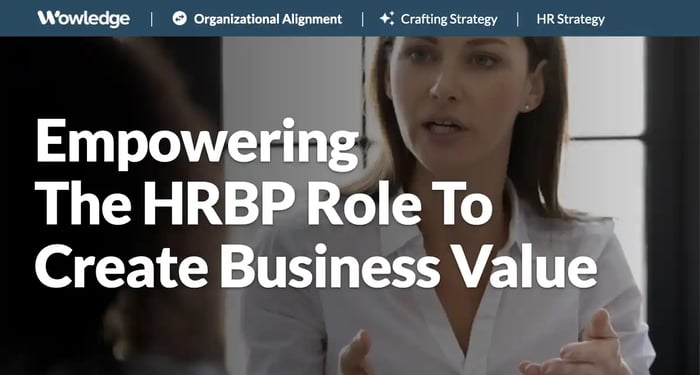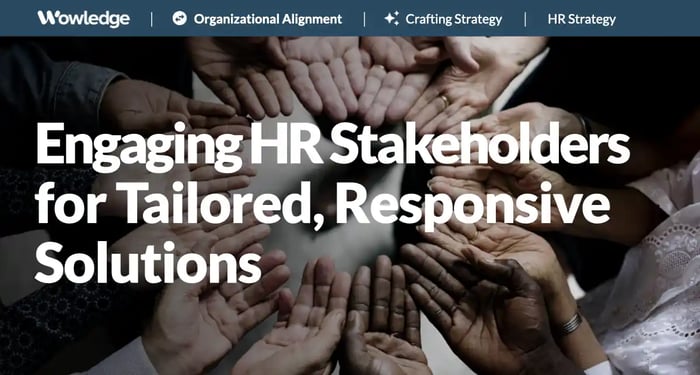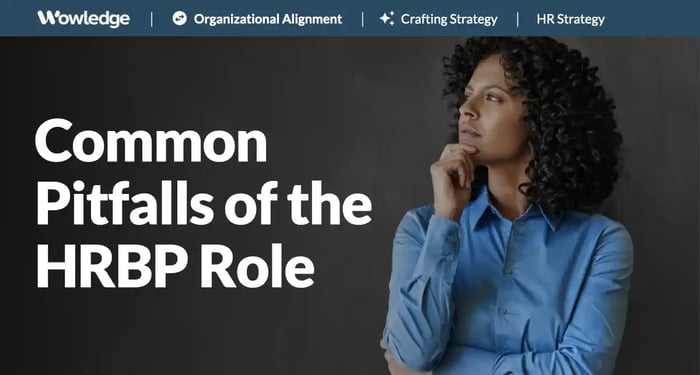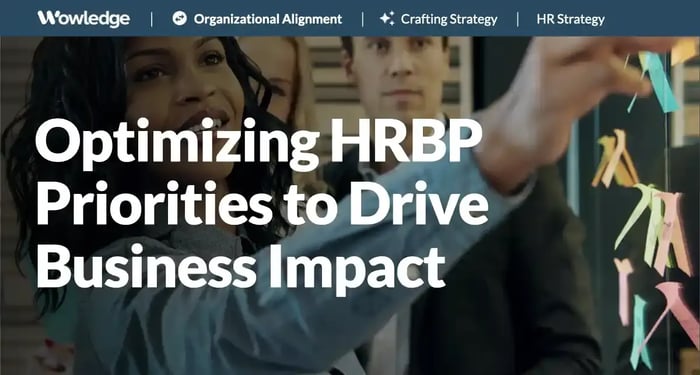Table of Contents
The HR Business Partner (HRBP) role holds an intriguing place within the human resources function because of its title. It can be assumed to be the primary strategic resource assigned to a leader, providing guidance, direction, and resources to meet the talent requirements of the leader’s function, location, or business unit. However, looking at the role across organizations, industries, and geographic boundaries, the duties, responsibilities, and contributions vary widely by design, execution, or happenstance. As a result, many in the role are either unable or underqualified to deliver on the promise of that strategic mandate. As these roles depend on delivering tailored HR solutions to business units and their teams, empowering the HRBP role should be a priority for HR leadership.
In previous blog posts, we discussed that HRBPs face numerous challenges when trying to contribute strategically, leading to common failures. Gartner’s research found that, on average, HRBPs spend nearly 19 hours per week on individual employee issues and another 16 hours on “daily operations,” leaving only a few hours available to focus on strategic business support activities. Similarly, Josh Bersin’s research team found that the HRBP role is underutilized, with a mere 24% of companies having HRBPs partner with business leaders on solution design and only 15% believing that their HRBPs have the necessary skills to redesign work or organizations.
Our position is that any description of the HRBP that includes handling employee relations issues, administrative challenges, benefits, or other common/mass employee-facing issues is badly misplaced, a misuse of the role. We have also discussed the differences between the HRBP role and the HR generalist with the “gens” handling individual employee issues, compliance, and HR process administration. Since many HRBPs currently handle those responsibilities, empowering the HRBP role to regain its strategic focus is crucial for improving and evolving the overall HR function.
Dave Ulrich, who introduced the concept of the role in his seminal book Human Resource Champions in 1996, said that:
“Many organizations recognize HR as a strictly functional role, which is an antiquated idea that fails to recognize decades of research demonstrating the impact HR has on business value and relevance. With that perspective firmly in place, many struggle to fully transform their ideology, leaving HR professionals in need of support to develop the ability to impact the business.”
That notion, shared over 25 years ago, still resonates today. Even though HR’s ability to positively impact organizational outcomes has been proven, many business leaders do not appreciate or understand it. Nonetheless, organizations should take to heart the need to be more proactive in leveraging the HRBP role more effectively.
For the record, the HRBP is not the only “strategic partner” on the team. Ulrich originally proposed that all HR leaders must embody expertise in four areas - strategic, administrative, employee champion, and change agent. That means that the leaders in the Centers of Excellence (COE) and those in HR Shared Services (HRSS) must also balance these perspectives and capabilities. Ulrich restates that notion in a recent contribution where one of his seven “lessons learned” about the HRBP role is: “Being a business partner may be achieved in many HR job categories.”
The difference, however, is that the HRBP role is designed as an expert in both HR and the business needs of its assigned client group. Thus, it is uniquely positioned to bring business and talent issues to the COE and HRSS teams so that they can develop integrated resolutions jointly. The focus on an intentionally strategic HRBP role is essential.
What defines a great HRBP?
Successful and fully utilized HRBPs focus on strategically understanding and leveraging an organization’s talent and talent-related capabilities to achieve targeted business objectives and outcomes. They concentrate on business goals, barriers, and shortcomings and create an objectively based understanding of how human performance and abilities are either driving or inhibiting them. They use a deep understanding of how the business operates and exceeds its goals and draw a line between optimized HR practices and those business outcomes.
Capable business partners identify opportunities for continuous improvement in designing and updating HR practices, processes, programs, and technologies to align with business needs. They develop a root-cause mindset that clarifies the reasons for underperformance. They rely on strong relationships with a broad network of experts across HR (COEs and Shared Services) and other corporate functions (Finance, Procurement, Security, etc.) and business unit leaders to define and integrate tailored solutions that address barriers and weaknesses that stand in the way of progress and optimization.
Unlike those in HR Manager or Generalist roles, Ulrich states that “The intent of the business partner model is to focus more on deliverables (what the business requires to win) than “doables” (what HR activities occur).” That continuous concentration on outcomes over process essentially defines the core element of the role. It is also often violated when a business manager asks the HRBP to help resolve a benefits enrollment issue. Or individual employee complaints about treatment by their manager. Refocusing the HRBP role requires them to resist such requests and hand those off to HR Managers or generalists.
To that end, research on the HRBP by the Talent Strategy Group found positive impacts on organizational performance when they participate in strategic or systemic enhancements and adverse effects when administrative or compliance dominates their activities. Other key priorities that drive impact include strengthening leadership capabilities and optimizing employee experiences, which have been demonstrated as critical contributions from the role.
Furthermore, Gartner found that companies that develop and support high-performing HRBPs enjoy the fruits of their efforts. Those organizations improved employee performance by 22%, retention by 24%, revenue by 7%, and profitability by 9%. Empowering the HRBP role as truly strategic offers significant advantages for the broader organization.

The challenges HRBPs encounter
The basic tenet of the HR function as a strategic partner and contributor calls for it to focus all its efforts and activities on the business versus itself. Unfortunately, the tendency to look inward comes out in many ways, with the symptoms of an internal focus sounding very familiar to many seasoned HR pros. Actions and activities that highlight the lack of this business-first focus include:
HR measurement and reports focused on its own processes
It has long been argued that HR tends to focus its reporting on the efficiency of its processes instead of their effect on and relationship to business objectives. Consider the prevalence of metrics such as time-to-fill, cost per hire, performance rating distribution, training hours per employee, and training satisfaction as stand-alone metrics or indicators. None demonstrate how the HR processes align with or influence corporate performance (e.g., revenue, profitability, staff utilization, market share, customer satisfaction.) Generating quality business impact metrics is key to empowering the HRBP role.
The lack of support and adoption of evidence-based HR (EBHR) and analytics
EBHR is a methodology that uses multiple sources of data and insight (internal and external) to identify talent-to-business relationships, drivers of operational improvement, root causes of underperformance, and below-standard talent outcomes that are identified drivers of organizational results. We continue to see low levels of advanced metrics, reporting, and analytics capabilities in HR outside some notably large and sophisticated industry leaders. The general lack of reliance upon external sources of insight into new and effective practices from academic or industry research combined with the advanced analyses of integrated internal HR and business operations data should and would generate precisely the type of insights that HRBPs use to determine issues, root causes, and potential solutions.
Poor strategic HR planning
Empowering the HRBP role and its efforts requires linking them directly to the business, and weaknesses in this critical arena continue haunting HR leaders and teams. Gartner reports that 66% of surveyed organizations acknowledge a lack of integration of business needs with their HR plans, and 38% lack alignment with corporate plans and do not adjust HR strategies with shifts in business plans. Furthermore, 58% do not have metrics tracking progress against plans, and only 28% review their plans for relevance during the year.
The HRBP role requires focusing on strategies that address future or emerging issues tied to known organizational risks. This includes potential disruptions from climatic, demographic, social, political, or supply chain events that impact economic, labor, and geographic markets. An added lack of integration of requirements from leadership with those of the external stakeholders— shareholders, customers, suppliers, distributors, and the community—is short-sighted.
Complexities that HRBPs need to be prepared to address
The current intersection of business and talent environments in which HRBPs are expected to operate and contribute is filled with potholes and barriers that require innovative and agile solutions. Empowering the HRBP role demands a deep appreciation and understanding of those essential to the successful planning and execution of the role of a business advisor, coach, and talent solution provider. Current issues that organizations and their sub-units (business units, functions, geographic locations) need help in identifying, understanding, and responding to include:
Talent shortages and skills obsolescence are impacting enterprise productivity and production requirements. Global labor markets are rife with low availability of required talent, from manual laborers to highly skilled professionals. Understanding her range of options for skill acquisition and management is crucial to ensure a sufficient supply of properly skilled labor is available to meet production requirements. With the rapid rise and attention paid to advanced technologies such as AI, automation, robotization, digital monitoring, collaboration systems, etc., HRBPs and the COE peers need to work together to understand the impact on jobs, tasks, and workflows. Associated changes in skill requirements and productivity expectations must be anticipated so that training, upskilling, and staffing level plans can be created to manage the fall-out of the adoption of these technologies effectively. Workforce planning is a necessary capability, even at the most basic level, to generate an analysis of budgeted headcount versus available headcount to identify the following year’s talent gaps that must be filled.
Return to work policies and practices represent productivity, performance, and innovation challenges. Balancing employee preferences with corporate management and cost considerations continues to challenge HR leaders. As most HRBPs are embedded in business operations of different sizes, locations, and types of work, identifying function or site-specific, tailored responses is essential to their sustainability. The impact of remote work on business-critical employee metrics is mixed – with some positives and other negatives – that need to be understood and monitored on a local and functional level to determine the best path forward.
Change disruption and over-saturation overwhelm many employees and distract them from quality, productivity, and innovation. Rapid advances and adoption of new workflow and workplace standards related to AI-related technologies, work location and scheduling, organization structures, performance monitoring and management, and cultural shifts are challenging employees’ natural desire for homeostasis. The lack of predictability in their workplaces contributes to a widely reported and heightened stress and burnout rate. Change management and planning skills are essential for empowering the role of the HRBP, given the preponderance of disruptive influences in the market today.
Managerial skills deterioration from increasing workload demands and generational shifts in employee expectations is creating a need for significant upgrades in handling managerial-level employees. Today’s historically low levels of employee engagement and high turnover/propensity to leave are vital indicators of poor managerial talent and behavior. Adding to that insight is Gallup's research that only 10% of managers have the proper blend of skills, capabilities, and traits. Understanding, measuring, and tracking managerial effectiveness are critical to syndicating improved managerial capabilities across the organization. More robust and effective selection, oversight, performance management, and expectation re-leveling are required to respond to increased demands and manager-to-employee ratios that lead to stress and burnout.
Cultural dis-alignment occurs due to internal changes, disruptions, and changes in the institutional and labor markets, and disengages employee attention from work responsibilities and the willingness to stretch with added effort. Too often, the stated and promoted organizational values or desired cultures fall out of alignment with leadership direction, managerial behaviors, policies and practices, and talent practices. Frequent turnover in executive ranks, ongoing Boomer and GenX retirement waves, acquisitions, mergers, and consumer preference shifts create changes that adjust the corporate culture. HRBPs must continually monitor and watch for shifts and inflection points that create disharmony between cultural aspirations and structural, workflow, cross-functional alignment/collaboration, and workforce changes.

Enable HRBP's focus and development
Given the challenges and issues facing organizations today, a well-designed, supported, and executed HRBP role is imperative to drive enhanced operational performance through its people. A combination of HRBP activities, skills and capabilities, and frameworks can drive their optimal focus.
Center on business outcomes
HRBPs must deeply understand how the organization(s) they support generate value. That requires deep awareness of how success is created in marketing and sales, finances, manufacturing, and customer support – whatever is relevant to the functions and businesses supported. Translating HR or talent practices, programs, policies, or initiatives into business impact is best assessed with advanced metrics and analytics. For example, conducting a regression analysis on the impact of a year of sales training program completions on generated revenue to understand the extent to which any of those contributed to growth can help identify which courses to continue and which to deemphasize.
The stated goals and performance requirements for each HRBP should involve succinct references to improving productivity, revenue and market growth, innovation, customer satisfaction, profitability, etc., as appropriate to align with the assigned business unit or function’s goals.
Create a disciplined approach
HRBPs should be guided by a framework that brings consistency across role incumbents and the businesses they serve. For example, the Talent Formula (competence X commitment X contribution) by the RBL team is a compelling framework that captures what it takes to fully engage and leverage talent within an organization. It can create, measure, and drive the focus of talent management solutions, concentrating HRBP oversight and monitoring of related systems, practices, and programs. The key elements refer to the effectiveness of those driving:
- Competence: managing the flow of people and needed skills into, through, and out of the organization.
- Commitment: achieving the employee value proposition, driving engagement and sentiment.
- Contribution: providing meaning and purpose to employee’s efforts.
Further insights from RBL focus on driving awareness and attention to the needs and requirements of the full range of organizational stakeholders, not only its leaders. It is crucial to understand how HR efforts can generate value for stakeholders beyond the immediate (leaders, employees, BOD) but also for the organization’s customers, communities, and investors. Examples of providing outputs that meet their needs include:
- Customers – build HR responses that drive customer satisfaction, loyalty, and share.
- Communities – HR programming and processes that generate or benefit social citizenship, community reputation, and positive/constructive regulatory relationships/compliance.
- Investors – focus HR efforts on activities that drive revenue and market growth, value, and prominence.
Leverage available resources and develop integrated solutions
Core to the HRBP value proposition is a combination of broad HR expertise and knowledge of the available HR resources and capabilities. They should bring the right combination of expertise into a problem-identification and resolution effort as a point guard or coach might in a basketball game. Understanding what is driving lower productivity and generating a resolution (e.g., tailored training, enhanced compensation, improved recruiting sources) requires a knowledge of what different functions (inside and outside of HR) can create and contribute.
Using comprehensive and proven methodologies (organization development, performance consulting, process reengineering, design thinking) to assess and design root-cause solutions brings credible proposals that are more likely to be approved due to the inclusion of key partners (e.g., in Finance, line management, HR COEs, etc.) Finally, developing a network of expertise, with repeated interactions, joint efforts, mentoring, and short-term job rotations, can help build trusted relationships between the HRBP and a robust community of experts with whom to collaborate.
These focus areas should also be used to determine HRBP development pathways, programming, and performance management goals and criteria.
HRBP skills to regain focus
Given the volume and range of challenges and organizational issues that HRBPs face and have the opportunity to contribute solutions for, anyone aspiring to or holding these jobs should be required to develop specific skills and capabilities over time. Starting with education and training, followed by opportunities to try them out on projects, HRBPs should subsequently be able to bring a full arsenal to the job. Recommended skills include:
1. Organization consulting and assessment
Objectively based, comprehensive evaluations of root causes using proven HR (OD or performance consulting) or operational (Lean, Six Sigma) methodologies. Conducting a consulting effort with assigned leaders/managers that effectively guides their thinking, opens their minds to possibilities, creates tailored options, and motivates change.
2. Analytics and interpretation
Understanding, performing (or guiding), and interpreting mathematical and statistical analyses from surveys, dashboards, and tailored analyses. Effectively develop a “story” or narrative to communicate trends, findings, conclusions, and action options.
3. Coaching and leader/manager development
Creating trusted and value-added relationships with leaders and managers to enable their growth, well-informed decision-making, and broadened “apertures” on challenges and issues that hinder organizational success. Identifying shortcomings and guiding or recommending leadership or management skills gap-closing opportunities.
4. Collaboration
Establishing associations and partnering meaningfully with leaders and subject matter experts (SMEs) externally and across other HR and peer functions. Network and effectively team with experts who can be leveraged for assistance with solution development, education on shared topics of interest, engagement as influencers or champions for change management purposes, or identifying resources for advanced analytics, purchasing & outsourcing, or problem-solving techniques.
5. Change and project management
Understanding of how change occurs and is most effectively driven in individuals and groups through communications, training, influencing, and repetition. Developing an initiative’s purpose, goals, objectives, and detailed plans and timelines to generate adoption and acceptance. Bringing the right people and resources together, generating measures and tracking processes, and leading a team(s) to conduct the activities and meet the project or change requirements.
Relevant Practices & Tools
Advanced HR Strategy Practices to Plan for Delivery of Impactful HR Services and Support. >
Advanced HR Strategy is a refined approach to planning long-term HR priorities. It involves increased specificity of plans and goals around key employee groupings and uses detailed... more »
Developing Internal Coaching and Mentoring Capabilities through Structured Learning and Development. >
When beginning to develop an internal coaching and mentoring capability, it is best to start by training a cadre of coaches and mentors using reputable vendors whose content... more »
Leveraging Workforce Planning and Analysis to Assess the Current State of Key Employee Segments. >
In its most basic form, a workforce planning effort builds an estimate of future headcount supply and demand for roles in the organization, with a subsequent gap analysis that yields insights... more »
Conducting Performance Consulting-based Learning Needs Assessments for Specialized Solutions. >
“Performance Consulting” is the act of resolving workplace performance shortcomings by using a disciplined approach to learning needs assessments... more »
Deploying Advanced Statistical Methods to Better Assess and Predict Trends in HR Processes, Policies, and Programs. >
Deploying advanced methods involves moving from descriptive or basic mathematical metrics (sums, averages, percentages, medians, etc.) to more sophisticated techniques... more »
About Wowledge
Wowledge is the expert-driven platform for lean teams building strategic HR programs. Members enjoy access to up-to-date best practices, step-by-step guides, tools, templates, and insights to accelerate the design and implementation of all key HR programs and processes.
Since each organization has unique characteristics, needs, and aspirations, Wowledge's practices are developed utilizing an exclusive stage-based approach – from Core to Advanced to Emerging – that reflects distinct levels of sophistication to meet our members where they are.
Build strategic HR programs with refreshingly easy-to-follow best practices.
Get started for FREE! Learn more.










